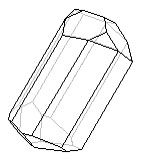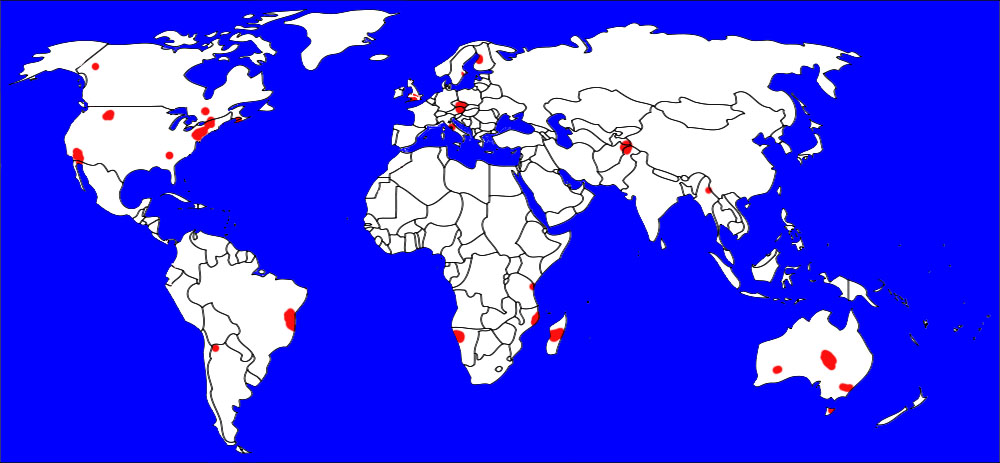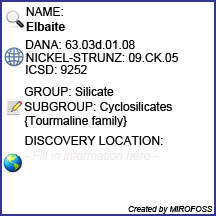

| Mineral Name | Elbaite |
| First Discovered | 1913 |
| Nickel-Strunz Classification | 09.CK.05 |
| Dana Classification | 63.03d.01.08 |
| ICSD | 9252 |
| Mineral Group | Silicates |


| Cleavage | Indistinct |
| Colour(s) | Blue, Colourless, Green, Yellow, Pink, White |
| Specific Gravity | 3.05 |
| Diaphaneity | Transparent to Translucent to Opaque |
| Fracture | Sub Conchoidal - Fractures developed in brittle materials characterized by semi-curving surfaces. |
| Mohs Hardness | 7.5 |
| Luminescence | Fluorescent, Short UV - weak blue to white |
| Luster | Vitreous (Glassy) |
| Streak | White |
| Habit(s) | Prismatic to Striated |
| Radioactivity | Non-radioactive |
| Magnetism | Non-magnetic |

No known health risks have been associated with elbaite. However ingestion of elbaite, as with other naturally occurring minerals, is not recommended.

The following image shows the elemental breakdown of the mineral elbaite along with the mineral crystal structure.


| Crystal System | Trigonal |  |
| Class | Pyramidal | |
| Axial Ratios | a : c = 1 : 0.44847 | |
| Morphology | Prismatic to Acicular | |
| Optical Data Type | Uniaxial (-) | |
| Dichroism (e) | Colourless | |
| Dichroism (w) | Colourless | |
| RL Values | nω = 1.633 - 1.651 nε = 1.615 - 1.630 | |
| Pleochroism | Visable |  |
| Max Birefringence | δ = 0.018 - 0.021 (See colour chart at right) | |
| Surface Relief | Moderate | |
| Dispersion | No | |
| Pleochroism | Weak |

Elbaite can be referenced in certain current and historical texts under the following five names:
| Arabic | Bulgarian | Chinese (Sim) | 锂电气石 | ||
| Croatian | Czech | Danish | |||
| Dutch | Esperanto | Estonian | |||
| Finnish | French | German | Elbait | ||
| Greek | Hebrew | Hungarian | |||
| Italian | Japanese | リシア電気石 | Korean | 얠볟으 | |
| Latin | Lithuanian | Norwegian | |||
| Persian | Polish | Portuguese | |||
| Romanian | Russian | Эльбаит | Slovak | ||
| Spanish | Elbaita | Swedish | Tagalog | ||
| Turkish | elbait | Ukrainian | ельбаіт | Vietnamese |

Elbaite can be found in a few places around the world. The map below shows major documented concentrations of elbaite:


 |
The MIROFOSS database offers free printable geological identification tags for personal and non-profit use. These tags can be used to properly identify mineral samples in your collection. -Click here- to download a full size jpeg image for a elbaite identification tag; which can be printed on paper or used with a plastic laser printer. |
 |
What's this? What can I do with it? |

| Chemical Composition | Grew, E.S., and Anovitz, L.M. (1996) BORON: Mineralogy, Petrology and Geochemistry, second edition, as revised (2002). |
| Crystallography | Bradley, J.E.S. & O. Bradley (1955), Observations on the colouring of pink and green zoned tourmaline Mineralogical Magazine: 30: 26-38. |
| Crystallography | Manning, P.G. (1969), An optical absorption study of the origin of colour and pleochrism in pink and brown tourmalines Canadian Mineralogist: 9: 678-690. |
| Crystallography | Donnay, Gabrielle & R. Barton (1972), Refinement of the crystal structure of elbaite and the mechanism of tourmaline solid solution: Tschermaks Mineral. Petrogr. Mitt.: 18: 273-286. |
| History | Agrosì, G., Bosi, F., Lucchesi, S., Melchiorre, G., and Scandale, E. (2006) Mn-tourmaline crystals from island of Elba (Italy): Growth history and growth marks. American Mineralogist: 91: 944-952. |
| Geograpcial Data | Mindat.org. Retrieved on 2012-10-24 |
| Physical Identification | Webmineral.com. Retrieved on 2012-10-24 |
| November 24, 2013 | The last time this page was updated |
| ©2017 MIROFOSS™ Foundation | |
 |